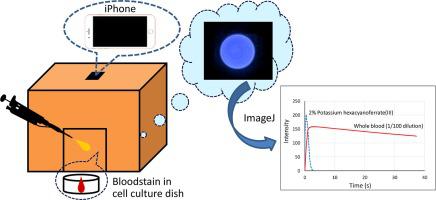当前位置:
X-MOL 学术
›
Forensic Chem.
›
论文详情
Our official English website, www.x-mol.net, welcomes your
feedback! (Note: you will need to create a separate account there.)
Luminol chemiluminescence reaction: optimization by image analysis method and use in distinguishing human hemoglobin from potassium hexacyanoferrate(III) by addition of ascorbic acid
Forensic Chemistry ( IF 2.6 ) Pub Date : 2020-12-01 , DOI: 10.1016/j.forc.2020.100278 Koichi Saito , Mayuka Kogure , Akihiro Sonoda , Rie Ito
Forensic Chemistry ( IF 2.6 ) Pub Date : 2020-12-01 , DOI: 10.1016/j.forc.2020.100278 Koichi Saito , Mayuka Kogure , Akihiro Sonoda , Rie Ito

|
Abstract The luminol chemiluminescence reaction (luminol reaction hereinafter) is used to detect trace amounts of blood at a crime scene. In this study, luminol chemiluminescence was recorded with a smartphone and image analysis was performed to optimize the luminol reaction for use in distinguishing chemiluminescence produced by whole blood from that by iron(III) ions. The video file was analyzed by the image analysis software ImageJ and a two-dimensional chemiluminescence intensity vs. time graph was created. When luminol reagent that is composed of a mixture of 0.4%(w/v) luminol dissolved in 1.0%(w/v) sodium hydroxide aqueous solution and 1.0%(w/v) hydrogen peroxide aqueous solution (6:1) was used, chemiluminescence duration was increased in whole blood sample, whereas that in potassium hexacyanoferrate(III) sample was extremely short, namely, a spike-like peak was generated. Furthermore, when ascorbic acid was added to potassium hexacyanoferrate(III) in the stoichiometric ratio of 0.58 mol or higher to 1.0 mol of iron(III) ion, the false-positive result produced by iron(III) ions was suppressed. From the above results, by optimizing the composition of luminol reagent, it became possible to distinguish chemiluminescence due to whole blood from that due to potassium hexacyanoferrate(III) on the basis of the difference in chemiluminescence pattern. It was also suggested that the addition of ascorbic acid could eliminate false-positive results produced by potassium hexacyanoferrate(III).
中文翻译:

鲁米诺化学发光反应:通过图像分析方法优化和通过添加抗坏血酸将人血红蛋白与六氰基铁酸钾(III)区分开来
摘要 利用鲁米诺化学发光反应(以下简称鲁米诺反应)来检测犯罪现场的微量血液。在这项研究中,使用智能手机记录鲁米诺化学发光,并进行图像分析以优化鲁米诺反应,用于区分全血产生的化学发光和铁 (III) 离子产生的化学发光。视频文件通过图像分析软件 ImageJ 进行分析,并创建了二维化学发光强度与时间图。当使用由 0.4%(w/v) 鲁米诺溶解在 1.0%(w/v) 氢氧化钠水溶液和 1.0%(w/v) 过氧化氢水溶液 (6:1) 中的混合物组成的鲁米诺试剂时, 全血样品的化学发光持续时间增加,而六氰基铁(III) 样品的化学发光持续时间极短,即,产生尖峰状峰。此外,当抗坏血酸以 0.58 mol 或更高的化学计量比添加到六氰基高铁酸 (III) 离子与 1.0 mol 铁 (III) 离子时,抑制了由铁 (III) 离子产生的假阳性结果。根据以上结果,通过优化鲁米诺试剂的组成,可以根据化学发光模式的差异区分全血化学发光和六氰基高铁酸钾(III)化学发光。也有人建议添加抗坏血酸可以消除六氰基高铁酸钾 (III) 产生的假阳性结果。抑制了铁(III)离子产生的假阳性结果。根据以上结果,通过优化鲁米诺试剂的组成,可以根据化学发光模式的差异区分全血化学发光和六氰基高铁酸钾(III)化学发光。也有人建议添加抗坏血酸可以消除六氰基高铁酸钾 (III) 产生的假阳性结果。抑制了铁(III)离子产生的假阳性结果。根据以上结果,通过优化鲁米诺试剂的组成,可以根据化学发光模式的差异区分全血化学发光和六氰基高铁酸钾(III)化学发光。也有人建议添加抗坏血酸可以消除六氰基高铁酸钾 (III) 产生的假阳性结果。
更新日期:2020-12-01
中文翻译:

鲁米诺化学发光反应:通过图像分析方法优化和通过添加抗坏血酸将人血红蛋白与六氰基铁酸钾(III)区分开来
摘要 利用鲁米诺化学发光反应(以下简称鲁米诺反应)来检测犯罪现场的微量血液。在这项研究中,使用智能手机记录鲁米诺化学发光,并进行图像分析以优化鲁米诺反应,用于区分全血产生的化学发光和铁 (III) 离子产生的化学发光。视频文件通过图像分析软件 ImageJ 进行分析,并创建了二维化学发光强度与时间图。当使用由 0.4%(w/v) 鲁米诺溶解在 1.0%(w/v) 氢氧化钠水溶液和 1.0%(w/v) 过氧化氢水溶液 (6:1) 中的混合物组成的鲁米诺试剂时, 全血样品的化学发光持续时间增加,而六氰基铁(III) 样品的化学发光持续时间极短,即,产生尖峰状峰。此外,当抗坏血酸以 0.58 mol 或更高的化学计量比添加到六氰基高铁酸 (III) 离子与 1.0 mol 铁 (III) 离子时,抑制了由铁 (III) 离子产生的假阳性结果。根据以上结果,通过优化鲁米诺试剂的组成,可以根据化学发光模式的差异区分全血化学发光和六氰基高铁酸钾(III)化学发光。也有人建议添加抗坏血酸可以消除六氰基高铁酸钾 (III) 产生的假阳性结果。抑制了铁(III)离子产生的假阳性结果。根据以上结果,通过优化鲁米诺试剂的组成,可以根据化学发光模式的差异区分全血化学发光和六氰基高铁酸钾(III)化学发光。也有人建议添加抗坏血酸可以消除六氰基高铁酸钾 (III) 产生的假阳性结果。抑制了铁(III)离子产生的假阳性结果。根据以上结果,通过优化鲁米诺试剂的组成,可以根据化学发光模式的差异区分全血化学发光和六氰基高铁酸钾(III)化学发光。也有人建议添加抗坏血酸可以消除六氰基高铁酸钾 (III) 产生的假阳性结果。











































 京公网安备 11010802027423号
京公网安备 11010802027423号